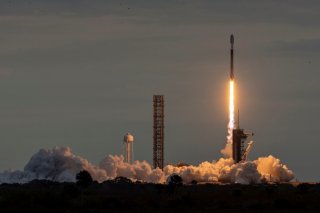Private Enterprise is America’s Key to the Modern Space Race
The vision of a greater human presence beyond Earth is becoming economically viable.
A new space race is developing between the United States and China. The future of this strategic competition will reshape space exploration and the industries that make it possible.
As both nations compete to reach the Moon and establish a permanent human presence beyond Earth’s orbit, the commercial industry—led by private space companies—is America’s best hope for staying ahead.
While the space race of the 1960s was primarily a pursuit of international prestige and technological demonstration, this modern competition will further encompass a high-technology domain. Space is among these new domains for great power competition.
As of 2020, the space economy is valued at $447 Billion, encompassing everything from telecommunications, earth observation, tourism, and research. Space assets are essential for our modern way of life, allowing for near-instantaneous communications worldwide. The historical constraint to the space economy’s growth has predominantly been the high cost of space launches. With the emergence of commercial space providers, that cost has been drastically reduced. Whereas the launch to low earth orbit onboard the Space Shuttle would cost $54,000/kg, today, the cost to LEO is less than $3,000/kg.
The military importance of the Space domain should not be underestimated. The United States is the most prolific user of military space systems to facilitate command and control for its worldwide presence. The emergence of anti-satellite weapons by adversarial nations disproportionately affects the United State’s power projection capabilities. Furthermore, as demonstrated by the utility of the Starlink system in Ukraine, a commercial space system could tip the balance of power in any asymmetrical modern conflict. Ensuring the resilience of U.S. space assets will remain a top concern in any ground-based conflicts.
China has made space a focus of its greater policy of displacing the United States as a world leader. China is providing an alternative framework for international partners to reach space, one that will represent the authoritarian states of the world and rival the American-led Artemis program. By building the Chinese space station, China is seeking to collect a cohort of middle space powers in an effort to establish its own vision of international space governance.
According to NASA, the International Space Station is set to retire in 2031, shifting focus to the Artemis “gateway” Moon orbiting space station. In the race to the Moon, China and Russia are collaborating to build a joint International Lunar Research Station moon base. Middle powers such as Pakistan and the United Arab Emirates have signed on to the initiative. Meanwhile, Venezuela and Malaysia are in discussions to join.
The rise of China as a leader in space would have far-reaching consequences for U.S. national security, potentially upending the principles of free access to space and commerce. A 2020 report concluded that China’s “zero-sum pursuit of space superiority” will harm U.S. competitiveness and pose a threat to U.S. space military readiness.
Among the most important players in the space industry is SpaceX, which has been able to squash foreign and domestic competitors to attract customers for its launch business. The United States has taken the economic lead in this new space race by possessing the most efficient space launch operation. SpaceX represents a paradigm shift in aerospace development philosophy. When SpaceX unveiled its mostly reusable Falcon 9 rocket, it drastically undercut the launch market; SpaceX remains the only entity in the world that has successfully landed an orbital-class rocket booster. The Falcon 9 booster has successfully landed 230 times and has been refurbished for hundreds of relaunches.
Today, we are experiencing the burgeoning start of the commercial space age dominated by private launch providers. Among these are SpaceX, Rocketlab, and Blue Origin; each has plans or contracts with NASA to facilitate a leading development role. Since the Space Shuttle’s retirement, NASA has increasingly transferred launch responsibilities to commercial partners (and the Russians). Today, NASA only operates the Space Launch System (SLS), the massive rocket set to take humans back to the Moon.
Private space companies have become game changers in the space launch industry and could secure the United States’s presence in the future space economy. SpaceX’s “iterative design” philosophy contrasts sharply with the traditionally lengthy government-led development programs, such as the SLS, which was nearly $2 billion over budget and years behind its projected schedule.
The most remarkable example has been the Starship, which is currently under development by SpaceX. It has progressed from paper to prototype to nearly fully operational in four years. This astonishing speed is a testament to the efficiency of America’s commercial space sector.
Starship is just the first of a new generation of commercial heavy-lift launch vehicles. Blue-Origin’s New Glenn, United Launch Alliance’s Vulcan Centaur, and Rocket Lab’s Neutron Rocket will normalize the commercialization of the new frontier. The vision of a greater human presence beyond Earth is becoming economically viable. Nevertheless, maintaining U.S. leadership in the space arena should be a primary focus of the administration.
Ian Ching is a Young Voices Contributor, Beyond Earth Institute Research Contributor, and a Masters candidate in International Relations at the Johns Hopkins School of Advanced International Studies.
Image: Shutterstok.com.

